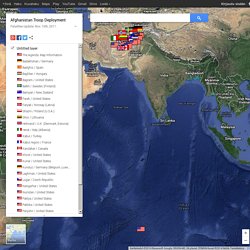

Who Is ISIS? 4 Important Facts About the Ruthless Terror Group in Iraq. August 15, 2014|6:09 am (Photo: Reuters/Stringer) A fighter of the Islamic State of Iraq and the Levant holds an ISIL flag and a weapon on a street in the city of Mosul, June 23, 2014.

The Islamic State of Iraq and Syria, also called the Islamic State of Iraq and the Levant, has garnered countless headlines across the globe. Their atrocities against religious minorities and effort to create an Islamic state in the Middle East have spurred international outrage as well as U.S. airstrikes. Below are four important points about ISIS, specifically its origins, military engagement, atrocities and denunciations from Muslim leaders. War in Afghanistan (2001–present) U.S.

President George W. Bush demanded that the Taliban hand over Osama bin Laden and expel al-Qaeda. The Taliban requested that bin Laden leave the country, but declined to extradite him without evidence of his involvement in the 9/11 attacks. The United States refused to negotiate and launched Operation Enduring Freedom on 7 October 2001 with the United Kingdom. The two were later joined by other forces, including the Northern Alliance.[23][24] The U.S. and allies drove the Taliban from power and built military bases near major cities across the country. In 2003, NATO assumed leadership of ISAF, with troops from 43 countries. Though vastly outgunned and outnumbered, the Taliban insurgents, most notably the Haqqani Network and Hezb-e-Islami Gulbuddin, have waged asymmetric warfare with guerilla raids and ambushes in the countryside, suicide attacks against urban targets and turncoat killings against coalition forces.
Historical background Origins of Afghanistan's civil war Al-Qaeda. Vs. Afghanistan. Gulf War. The Gulf War (2 August 1990 – 28 February 1991), codenamed Operation Desert Shield (2 August 1990 – 17 January 1991) for operations leading to the buildup of troops and defense of Saudi Arabia and Operation Desert Storm (17 January 1991 – 28 February 1991) in its combat phase, was a war waged by coalition forces from 34 nations led by the United States against Iraq in response to Iraq's invasion and annexation of Kuwait.

The war is also known under other names, such as the Persian Gulf War, First Gulf War, Gulf War I, Kuwait War, First Iraq War, or Iraq War[14][15][16][a] before the term "Iraq War" became identified instead with the 2003 Iraq War (also referred to in the U.S. as "Operation Iraqi Freedom").[17] The Iraqi Army's occupation of Kuwait that began 2 August 1990 was met with international condemnation, and brought immediate economic sanctions against Iraq by members of the U.N. Security Council.
U.S. President George H. W. Etymology[edit] Operational names[edit] Background[edit] Afghanistan Troop Deployment. Fatalities Update: Nov. 10th, 2011.

Click on "The Agenda: Map Information" icon for more details. This map displays the NATO countries contributing to the military mission in Afghanistan. The map provides information on troop deployments, mission parameters, and reported fatalities. There are currently more than 147,000 troops stationed Afghanistan. International troops are scheduled to withdraw from Afghanistan in late 2011. Who Is ISIS? 4 Important Facts About the Ruthless Terror Group in Iraq. War in Afghanistan (2001–present) The Forgotten War by Tom Engelhardt. Listen to Ann Jones on Monday’s Scott Horton Show The Afghan War is officially winding down.

American casualties, generally from towns and suburbs you’ve never heard of unless you were born there, are still coming in. Though far fewer American troops are in the field with Afghan forces, devastating “insider attacks” in which a soldier or policeman turns his gun on his American allies, trainers, or mentors still periodically occur. Civilian casualties continue to rise.
“Surgically precise” U.S. air and drone strikes still mysteriously kill Afghan civilians. Meanwhile, as TomDispatch regular Ann Jones points out, our second longest war has already played Houdini, doing a remarkable disappearing job in “the homeland.” Today, Ann Jones, who spent years in Afghanistan working with Afghan women and wrote a striking book, Kabul in Winter, based on her experiences, considers the Afghan end game and what to make of it. Nothing like her account exists. By Ann Jones. The American Agenda in Afghanistan: a Civilian’s Review. Kabul.

One thing true we can say about war is that truth is its greatest casualty. I am a volunteer teacher. Four years ago I responded to a call from then candidate Barack Obama for a new kind of soldier to wage peace, one without a uniform, without a gun. On the three-year anniversary of my moving in with the orphans here in Afghanistan, I listened to gun battle and explosions in my Kabul neighborhood for ten hours through the night and into the morning.